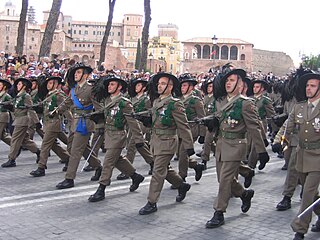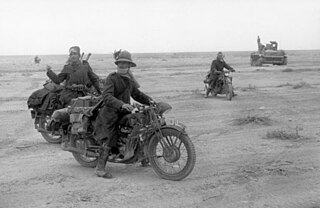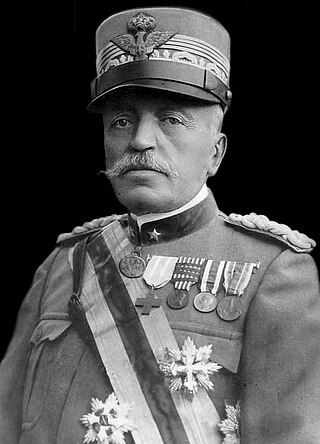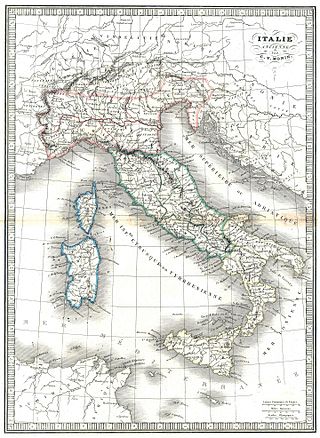
The Battle of Caporetto took place on the Italian front of World War I.
An army group is a military organization consisting of several field armies, which is self-sufficient for indefinite periods. It is usually responsible for a particular geographic area. An army group is the largest field organization handled by a single commander – usually a full general or field marshal – and it generally includes between 400,000 and 1,000,000 soldiers.

The Bersaglieri, singular Bersagliere, are a troop of marksmen in the Italian Army's infantry corps. They were originally created by General Alessandro Ferrero La Marmora on 18 June 1836 to serve in the Royal Sardinian Army, which later became the Royal Italian Army. They can be recognized by their distinctive wide-brimmed hats decorated with black western capercaillie feathers, which is worn with the dress uniform. The feathers are also applied to their combat helmets.

The 1st Army was a Royal Italian Army field army, in World War I, facing Austro-Hungarian and German forces, and in World War II, fighting on the North African front.

The Italian front was one of the main theatres of war of World War I. It involved a series of military engagements along the border between the Kingdom of Italy and Austria-Hungary from 1915 to 1918. Following secret promises made by the Entente in the 1915 Treaty of London, the Kingdom of Italy entered the war on the Entente side, aiming to annex the Austrian Littoral, northern Dalmatia and the territories of present-day Trentino and South Tyrol. The front soon bogged down into trench warfare, similar to that on the Western Front, but at high altitudes and with extremely cold winters. Fighting along the front displaced much of the local population, and several thousand civilians died from malnutrition and illness in Kingdom of Italy and Austro-Hungarian refugee camps.

Otto Ernst Vinzent Leo von Below served as a Prussian general officer in the Imperial German Army during the First World War (1914–1918). He arguably became most notable for his command, along with the Austro-Hungarian commander Svetozar Borojević, during the victorious Battle of Caporetto in October–November 1917.
The 10th Army was a field army of the Royal Italian Army, which fought in World War I and in Italian North Africa during World War II.

Marshal of Italy Luigi Cadorna, was an Italian general, Marshal of Italy and Count, most famous for being the Chief of Staff of the Italian Army from 1914 until 1917 during World War I. Commanding the Italian army on the Italian front, he acquired a reputation for rigid discipline and the harsh treatment of his troops. Cadorna launched multiple offensives across the Isonzo front during which the Italian army made gradual gains, notably capturing Gorizia after containing the Strafexpedition, but suffered heavy casualties. Following a major defeat at the Battle of Caporetto in late 1917, he was relieved as Chief of Staff.

The Battle of Vittorio Veneto was fought from 24 October to 3 November 1918 near Vittorio Veneto on the Italian Front during World War I. After having thoroughly defeated Austro-Hungarian troops during the defensive Battle of the Piave River, the Italian army launched a great counter-offensive: the Italian victory marked the end of the war on the Italian Front, secured the dissolution of the Austro-Hungarian Empire and contributed to the end of the First World War just one week later. The battle led to the capture of over 5,000 artillery pieces and over 350,000 Austro-Hungarian troops, including 120,000 Germans, 83,000 Czechs and Slovaks, 60,000 South Slavs, 40,000 Poles, several tens of thousands of Romanians and Ukrainians, and 7,000 Austro-Hungarian loyalist Italians and Friulians.

The Russian Expeditionary Force [REF] was a World War I military force sent to France and Greece by the Russian Empire. In 1915, the French requested that Russian troops be sent to fight alongside their own army on the Western Front. Initially they asked for 300,000 men, an unrealistically high figure, probably based on assumptions about Russia's 'unlimited' reserves. General Mikhail Alekseev, the Imperial Chief of Staff, was opposed to sending any Russian troops, although Nicholas II finally agreed to send a unit of brigade strength. The first Russian brigade finally landed at Marseille in April 1916.
The Tenth Army was a Field army of the French Army during World War I and World War II.
The 2nd Army Corps was first formed before World War I. During World War II it fought in the Campaign for France in 1940 and during the 1944–45 campaigns in southern France, the Vosges Mountains, Alsace, and southwestern Germany. It was active under the First Army for many years after World War II.

Although a member of the Triple Alliance, Italy did not join the Central Powers – Germany and Austria-Hungary – when the war started with Austria-Hungary's declaration of war on Serbia on 28 July 1914. In fact, the two Central Powers had taken the offensive while the Triple Alliance was supposed to be a defensive alliance. Moreover the Triple Alliance recognized that both Italy and Austria-Hungary were interested in the Balkans and required both to consult each other before changing the status quo and to provide compensation for whatever advantage in that area: Austria-Hungary did consult Germany but not Italy before issuing the ultimatum to Serbia, and refused any compensation before the end of the war.

The 117th Infantry Division was a formation of the Imperial German Army in World War I. The division was formed on April 2, 1915, and organized over the next several weeks. It was part of a wave of new infantry divisions formed in the spring of 1915. The division was disbanded in 1919, during the demobilization of the German Army after World War I.

The Allied leaders of World War I were the political and military figures that fought for or supported the Allied Powers during World War I.
The Armée d'Orient (AO) was a field army of the French Army during World War I who fought on the Macedonian front.

During World War I, France was one of the Triple Entente powers allied against the Central Powers. Although fighting occurred worldwide, the bulk of the French Army's operations occurred in Belgium, Luxembourg, France and Alsace-Lorraine along what came to be known as the Western Front, which consisted mainly of trench warfare. Specific operational, tactical, and strategic decisions by the high command on both sides of the conflict led to shifts in organizational capacity, as the French Army tried to respond to day-to-day fighting and long-term strategic and operational agendas. In particular, many problems caused the French high command to re-evaluate standard procedures, revise its command structures, re-equip the army, and to develop different tactical approaches.
The 31st Army Corps was a corps of the French army, created at the start of the First World War. From the date of its creation until June 1916, the army corps occupied front sectors in Lorraine. In June, the 31st Army Corps fought on the left bank of the Meuse during the Battle of Verdun. Subsequently, it occupied a front line sector in the Argonne, before being transported to the Italian Front as a reinforcement after the Italian defeat at the Battle of Caporetto with the 10th Army. In March 1918, the army corps was redeployed to France, to face the German offensives, it was situated on the Somme front until the end of the war.
122nd Infantry Division was an infantry division of the French Army during the First World War. It was deployed overseas, seeing action on the Salonika front, fighting alongside British troops. It was sent to the Crimea in December 1918 as part of the Army of the Danube.
57th Infantry Division was an infantry division of the French Army during the First World War. It was deployed overseas, seeing action on the Salonika front, fighting alongside British troops. It was sent to the Crimea in December 1918 as part of the Army of the Danube.














